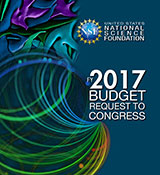- Home
- Agencies
- Department of Agriculture
- Department of Housing and Urban Development
- General Services Administration
- Department of Commerce
- Department of the Interior
- National Aeronautics and Space Administration
- Department of Defense
- Department of Justice
- National Science Foundation
- Department of Education
- Department of Labor
- Office of Personnel Management
- Department of Energy
- Department of State
- Small Business Administration
- Environmental Protection Agency
- Department of Transportation
- Social Security Administration
- Department of Health and Human Services
- Department of the Treasury
- U.S. Agency for International Development
- Department of Homeland Security
- Department of Veterans Affairs
- Goals
- Initiatives
- Programs
Primary tabs
Strategic Objective
Use effective methods and innovative solutions to achieve excellence in accomplishing the agency’s mission
Strategic Objective
Overview
NSF can accomplish our mission only when our operational and administrative enterprise functions work seamlessly with the front-line organizations they support. A wide range of services--including human resources; performance management; information technology (IT); financial, procurement, and administrative support--provide the wherewithal for the agency’s program staff and leadership to make critical investments in science, research, engineering, and education.
The agency uses three key strategies to achieve organizational excellence: openness, inclusion, and effectiveness. Openness and inclusion are achieved when we conduct business in a transparent, collaborative, and participatory manner with all stakeholders. Continuous, clear communication with all parties is a hallmark of openness and inclusion. An organization is effective when all business processes work to optimize administrative efficiencies, provide business intelligence for data-driven decision making, and enable organizational agility.
An essential mechanism that NSF uses to accomplish our mission is the competitive merit review of research proposals. We have developed a strong business and operations model that is emulated around the world. This model uses frontline U.S. researchers who have the best sense of where opportunities for major advances lie to evaluate proposals for original research. NSF accepts proposals in a manner that represents an open portal for new ideas in all fields, including interdisciplinary proposals. Whether they are submitted in response to open funding opportunities or for formal targeted solicitations, the proposals undergo merit review, with the subject matter experts (peers) assessing the intellectual merits and broader impacts of the proposed research. This merit review may take many forms, but all are designed to provide NSF program officers with the information they need to make award recommendations from among the (usually) large number of high-quality possibilities. The agency’s IT systems are critical to the process, facilitating the flow of proposals through the merit review, award, and oversight processes. External members of the research community periodically assess the quality of the merit review process as a means of accountability for NSF management and staff. Construction and operation of large scientific instruments and infrastructure efforts present added challenges. NSF requires extensive project execution plans, including detailed work scope, milestone schedules, and risk management; progress is monitored continually by NSF staff using extensive Earned Value Management (EVM) data, supplemented by in-depth external reviews conducted at least once a year.
Read Less...Progress Update
The Strategic Review used several sources of evidence to address the key analytical questions, including previous customer satisfaction surveys, evaluation reports, administrative data, a review of customer service performance measures at other agencies (NIH, USDA, NASA, DOE, Education, VA), a panel discussion with the National Science Board, and a small sample of survey responses from program directors and principal investigators (PI) to questions about customer service.
The strategic review team considered the advantages and disadvantages of dwell time versus other metrics of customer service. Three characteristics of customer service were determined to be important: Quality, transparency, and timeliness. The current dwell time goal addresses only timeliness of providing review feedback to the customer. It does not encourage or incentivize other aspects of customer service, such as providing specific post-review feedback to PIs. As part of the Strategic Review, NSF conducted a panel discussion with members of the National Science Board, where members encouraged NSF to consider quality as well as timeliness in our customer service goals. One National Science Board member commented that “speed without quality is not a good standard to have, as one can do a bad job quickly.”
The Strategic Review used internal data to assess the impacts on work processes to determine whether the dwell-time goal has unintended consequences on workload or on the review process. The evidence demonstrated that the timing of budget appropriation and current plan implementation does not impact dwell time. However, the dwell time goal encourages staff to process declines before awards because they can be done faster, which creates conflict with award leveling.
The data also show that since 2010 NSF is utilizing fewer total reviewers and fewer new reviewers for more proposals, thereby including less of the community in our review process. This decrease could be due to time limitations to recruit reviewers or the increasing change from ad hoc to panel review. It is difficult to disambiguate the effects of the increasing number of proposals generally as opposed to the specific pressure of a dwell time goal/efficiency measure.
The strategic review determined that additional feedback from customers is needed to assess which aspects of customer service should be the targets of a new customer service goal. In FY 2015, NSF began to conduct a survey with NSF PIs and reviewers that included questions about customer service. The forthcoming results of this survey will be used to identify targets for a new customer service goal focused on quality.
Opportunities for Action or Improvement
• Develop and pilot ideas for additional customer service goals based on the results of the upcoming customer service survey and analysis of PI behavior.








